Table of contents
- Proper chain maintenance on a motorcycle Clamp and lubricate
- Function of the motorcycle chain
- Structure of the motorcycle chain
- Lubricate the motorcycle chain properly
- Clean the motorcycle chain properly
- Tensioning the motorcycle chain
- More about technology
- Retensioning the motorcycle chain
- Wear check on the motorcycle chain
- You need that for chain maintenance
- Conclusion
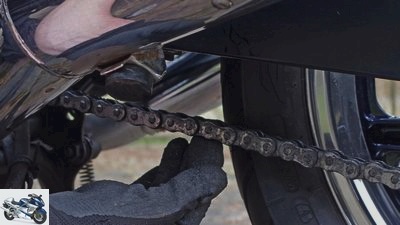
Photo: Ralf Petersen
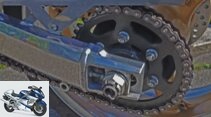

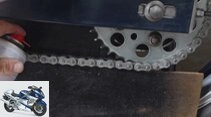
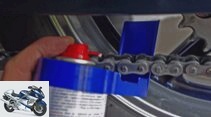
13th pictures

Ralf Petersen
1/13
/ 1 / A typical lack of maintenance: everything sparkling clean, even the chain.
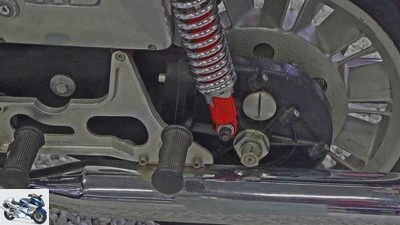
Ralf Petersen
2/13
/ 2 / Not pretty, but effective: the closed chain case.
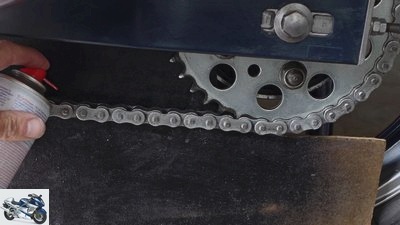
Ralf Petersen
3/13
/ 3 / When lubricating: Cover the tire and rim over a large area.
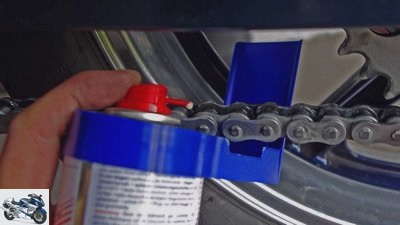
Ralf Petersen
4/13
/ 4 / Ingeniously simple: practical can attachment as a splash guard.
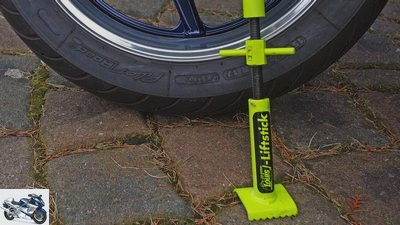
Ralf Petersen
5/13
/ 5 / No main stand? A lift stick does a good job.
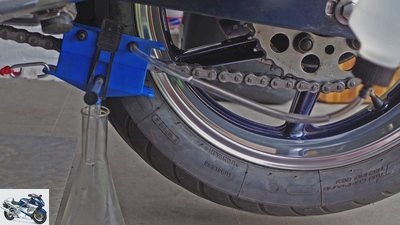
Ralf Petersen
6/13
/ 6 / A clean affair: cleaning work with the Kettenmax.
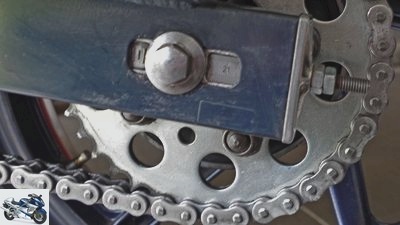
Ralf Petersen
7/13
/ 7 / Ready for use again: cleaned and lubricated chain.

Ralf Petersen
8/13
/ 8 / The sag test is carried out with the machine jacked up.
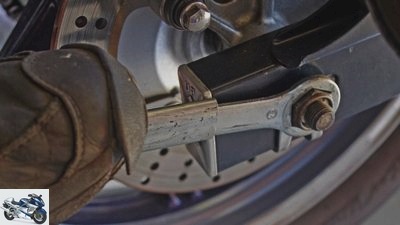
Ralf Petersen
9/13
/ 9 / Always tricky: loosening the axle nut with on-board tools.
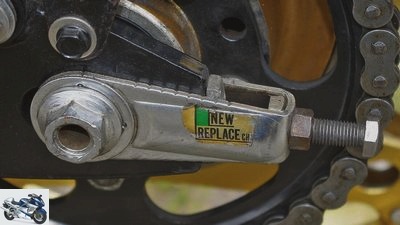
Ralf Petersen
10/13
/ 10 / Usually too imprecise: chain tensioners with markings.

Ralf Petersen
11/13
/ 11 / Checking the correct chain alignment using a laser tool.
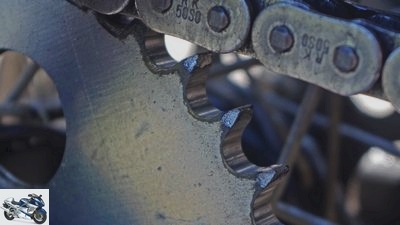
Ralf Petersen
12/13
/ 12 / And the shark, it has teeth … Time to change its chains.
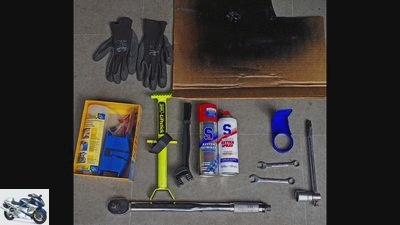
Ralf Petersen
13/13
What is needed: chain spray, protective cover, chain cleaner, brush / Kettenmax, tools for loosening the rear axle / chain tensioner, lift stick / lifter, gloves, repair instructions
counselor
workshop
Tips for mechanics – correct motorcycle chain maintenance
Proper chain maintenance on a motorcycle
Clamp and lubricate
The subject of chain maintenance is so sick of many motorcyclists. But hand on heart: do you really do it properly and regularly? Our screwdriver refreshes our knowledge of the greasy articulation.
Ralf Petersen
March 16, 2018
A motorcycle chain is an important component of the machine, the care and maintenance of which should not be neglected. Otherwise there is a risk not only of faster wear and tear and thus expensive replacement, but also a loss of performance and stronger load change reactions, which can cause unrest in the chassis. In addition, a worn or incorrectly tensioned chain also harbors a safety risk because it can break off, skip or even tear.
Buy complete article
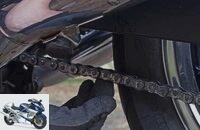
Proper chain maintenance on a motorcycle
Clamp and lubricate
4 pages) as PDF
€ 2.00
Buy now
Function of the motorcycle chain
On motorcycles, the chain is one of the most common types of power transmission between the engine and the rear wheel. In contrast to the cardan or toothed belt alternatives also used in motorcycle construction, it is lighter and cheaper to produce. Above all, however, it has the best efficiency, so that there is less power loss in power transmission. However, this only applies to a correctly tensioned and lubricated chain. In addition, the transmission ratio can be changed relatively easily by using other sprockets.
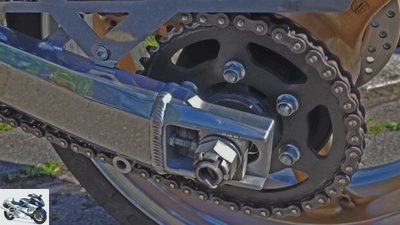
Ralf Petersen
A typical lack of maintenance: everything sparkling clean, even the chain.
The main disadvantage of the chain is clear: its care and maintenance intensity. There have been repeated attempts to find a sensible and, above all, clean solution. The Munch Mammut and Yamahas TR1 even had a closed chain case filled with grease. A sensible chain guard that covers the chain at least towards the tire (e.g. on the Honda X-ADV scooter) is unfortunately rare these days, even on touring motorcycles. As a rule, the chain runs more or less unprotected. That is why it has to be relubricated regularly (every 300 to 500 km) and cleaned if necessary – actually a joke in the 21st century.
Structure of the motorcycle chain
Motorcycle chains are precision products. The manufacturing tolerances are very high and the materials used are of the highest quality. The now almost exclusively used so-called O-ring chains, which have been around since the mid-1970s, ensure adequate lifetime lubrication of the sleeve and chain pin thanks to sealing rings behind the chain link – but only inside the chain. The unprotected outer part (rollers, pinion and sprocket) requires sufficient lubrication, for which the driver is responsible.
Lubricate the motorcycle chain properly
The centrifugal force – combined with rain and road dirt – ensures that a chain over time “blank” and then wears out in no time. While a well-lubricated chain can last up to 40,000 km, neglected examples are often at the end of their service life after less than 10,000 km. Regular (visual) checks are therefore essential. If the chain is bare or even shows traces of rust, chain spray is used, which not only protects the chain from corrosion, but also significantly reduces friction. In order for it to adhere well, however, the chain must be clean and dry. For better distribution of the strongly adhesive lubricant, the manufacturers have added a propellant that evaporates after a short time. Experienced touring riders therefore immediately lubricate the chain that is still warm at the end of a tour and can start straight away the next morning. If, on the other hand, you drive off immediately after lubrication, the lubricant is wonderfully distributed over the rim, brake disc and tire.
- Place the motorcycle on the main stand or assembly stand.
- It is best to cover the tire and rim with cardboard etc..
- Spray chain spray on the inside of the chain on the lower chain strand. Turn the wheel by hand.
- Throw away the cardboard and you’re done.
Important: It’s not the amount that matters – it’s better to relubricate more often! A splash guard (e.g. S100 Saubersepp) and a so-called lift stick for motorcycles without a main stand, with which the rear wheel can be lifted when the bike is on the side stand, is practical for on the go.
An alternative to spray are permanent lubrication systems such. B. the Scottoiler. These chain oilers, which are not exactly cheap, are activated by ignition current or negative pressure, and a thin oil drips directly onto the sprocket while driving. However, adjustments must be made depending on the conditions (rain / dust) and the route.
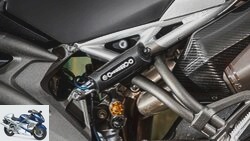
workshop
Chain lubrication system Scottoiler xSystem
Electronics monitor dosing
read more
Clean the motorcycle chain properly
If dirt and dust particles combine with the chain grease, the lubricating effect is reduced. Dirty chains should therefore be cleaned. Light soiling can be easily removed with a plastic brush.
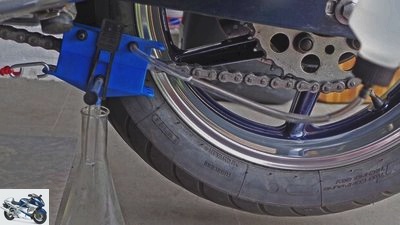
Ralf Petersen
A clean affair: cleaning work with the Kettenmax.
In the case of coarse soiling, you should neither use steam jets nor brake cleaner (attacks the O-rings), but use a special chain cleaner.
The Kettenmax (Polo, from approx. 20 euros) has proven itself in order to keep the mess that logically arises in the process. It cleans the chain from all sides with the help of small brushes and a cleaning liquid, but most importantly, the dirt is directed into a collecting container via a hose.
Tensioning the motorcycle chain
A chain stretches continuously over the course of its more or less long life. The reason is the wear on the friction surfaces of the bolts. Therefore, the voltage must also be checked regularly. Already the term “Tension the chain” is misleading because it is about setting the so-called slack, i.e. H. of the game that the chain must have. This play is necessary so that the rocker can move during compression and rebound, while an inclined rocker shortens the distance between the pinion and the sprocket. The chain drive only reaches its maximum length when the gearbox output shaft, pivot point and wheel axle are on one axis. If the chain is too tight, the suspension will be impaired and the chain will be stretched excessively.
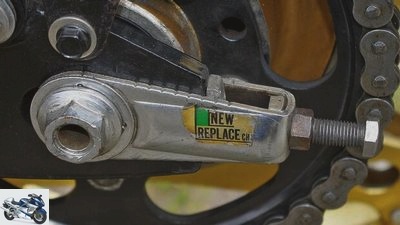
Ralf Petersen
Usually too imprecise: chain tensioner with markings.
The result is extremely high wear and tear and increased pressure on the gearbox output bearing, which can prematurely give up its ghost. In the worst case, the chain can even break. A chain that is tensioned too loosely whips and hits when the accelerator is released, wears out faster and in extreme cases can jump off or jump over – so be careful here too. To check the correct sag, the machine is jacked up again so that the rear wheel can be turned. Since older chains are often unevenly elongated, you can check the slack in the middle of the lower chain strand by lifting the chain with your fingers. Then the wheel is turned a little further and the procedure is repeated until the tightest point is found. That is decisive for the tension.
If the chain is completely unevenly elongated, it can only be exchanged, as reasonable tension is no longer possible. The slack in the chain is theoretically okay if it is approx. 3 to 5 cm when the machine is jacked up. Exact information can be found in the driver’s manual or, with some types, are also stuck on the swing arm. But be careful: the chain must still have play even when it is fully loaded. Depending on the design of the machine, the game changes to a greater or lesser extent with or without a load. Just try it out. But if you sit on the machine, it is very difficult to check the slack without acrobatic contortions – you need a second person. Important: When traveling on holiday with luggage, the sag must be checked with the machine loaded and corrected if necessary.
More about technology
PS knowledge: technology
- Motorcycle technology clearly explained on 97 pages (PDF)
- From starter to spark plug
- Simple teaching of physical principles
- Tips and tricks for practitioners
To the PDF for € 9.99
#image.jpg
Retensioning the motorcycle chain
Jack up the motorcycle and engage a gear to re-tension. First the rear axle must be loosened on the side of the axle nut. It is often very tight (usually 100 Nm and more!). If necessary, remove the splint etc. beforehand. To tension the chain, the rear wheel must be pulled back (this happens automatically by the chain tensioner), to loosen it must be pushed forward (to do this, after loosening the chain tensioner, you have to press / hit the wheel vigorously). There are different types of chain tensioners, unfortunately qualitatively very different, but they mostly work on a similar principle. The chain tensioner usually has an adjusting screw secured by a lock nut. The chain is tightened / loosened by evenly turning the screws on both sides.
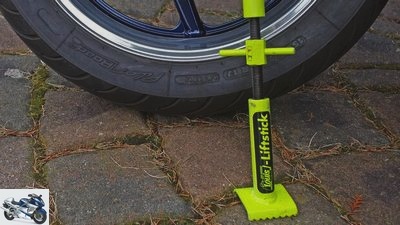
Ralf Petersen
No main stand? A lift stick does a good job.
Do this alternately in quarter turns until the chain reaches the correct slack. There are (more or less exact) markings on the swing arm and the chain tensioners. It is important that the markings on both sides of the swing arm are in the same position, otherwise the bike will skew and affect the handling. If you don’t trust the often inaccurate markings, you can also use a chain laser (at Polo around 40 euros) to check the escape. A laser beam on the link plates makes an incorrect setting visible. After tightening the axle nut (observe the torque) it is essential to check the chain tension again. Do not despair if it doesn’t work right away, tensioning has a lot to do with experience and patience – practice makes perfect!
The whole thing should not only work in the garage at home, but also on a tour. In order to do this with the on-board tool kit, you also have to know the trick. The rear wheel axle nut can only be loosened if you press down hard with your foot on the undersized (on-board) tool, which should be replaced in good time with a sensible tool (suitable nut / toggle).
Wear check on the motorcycle chain
A chain is worn if it has elongated unevenly or too much. Some motorcycles have a practical wear indicator. When the marking has reached the red area, the chain must be changed. Alternatively, you can check whether the correctly tensioned chain can be lifted more than three millimeters from the chain wheel with a screwdriver at the end of the chain wheel.
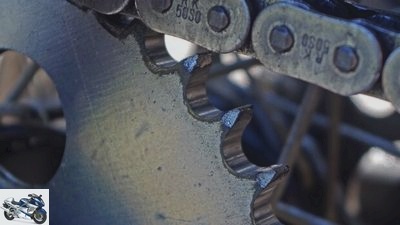
Ralf Petersen
This is what the so-called shark teeth look like … Time to change the chain.
The teeth of the sprocket also get thinner and thinner due to abrasion over time, so-called shark teeth develop. They can then no longer withstand the enormous forces and bend, so that in extreme cases the chain slips over the sprocket. But the wear is not always so evident.
Lateral play, twisted bolts, defective rollers and noticeably sluggish or easy-moving chain links or defective sealing rings also require a careful visual inspection. In all cases, the complete chain set (i.e. chain, pinion and sprocket) must be replaced.
You need that for chain maintenance
- Chain spray
- Cover protection
- Chain cleaner
- Brush / chain max
- Tool for loosening the rear axle / chain tensioner
- Liftstick / lifter
- gloves
- Repair manual
Material / acquisition costs:
A good branded chain spray is available in accessories shops (e.g. from the large chain stores) from around ten euros and offers plenty of supplies for a lot of maintenance work on the chain. A sensible investment is the purchase of little helpers that really round off your own screwdriver equipment: Kettenmax cleaning box (20 euros), Saubersepp splash guard (from 5 euros), laser to escape (40 euros).
Conclusion
Cardan drivers can only laugh about chain maintenance. But if you have a chain drive on your motorcycle, you shouldn’t neglect the sometimes greasy business. A chain with a long life thanks to good care.
Related articles
-
Maintenance and care of chain, cardan shaft, toothed belt
Ralf Petersen 15th pictures Ralf Petersen 1/15 Chain, cardan or toothed belt differ not only in their functionality, but also in terms of maintenance and…
-
Tips for mechanics: Maintenance of motorcycle cooling systems
Ralf Petersen 15th pictures Ralf Petersen 1/15 We explain how the maintenance of a cooling system works. Ralf Petersen 2/15 This is needed for…
-
Screwdriver tips for motorcycle seats
Ralf Petersen 13th pictures Ralf Petersen 1/13 Ralf Petersen 2/13 Ralf Petersen 3/13 Ralf Petersen 4/13 Ralf Petersen 5/13 Ralf Petersen 6/13 Ralf…
-
Tips for wintering the motorcycle: Short and sweet for the impatient
Jorg Lohse counselor workshop Tips for wintering the motorcycle: Short and sweet for the impatient Tips for wintering the motorcycle Short and sweet for…
-
Clean and maintain motorcycle chains
archive accesories Clean and maintain motorcycle chains Advice: chain maintenance How do I properly care for the chain on my motorcycle?? Your…
-
Oil care tips for the motorcycle
Schoch 30th pictures Schoch 1/30 With olive oil from mom’s kitchen, the shine of plastic parts on the motorcycle can be permanently restored. Schoch 2/30…
-
Tips and tricks – taking photos on motorcycle trips
Jo Deleker 22nd pictures Jo Deleker 1/22 Tips and tricks: Simply take better photos. Jo Deleker 2/22 Golden ratio: One of the most important design…
-
Correct cornering with the motorcycle
Jahn 28 pictures Kawasaki 1/28 Curves are the icing on the cake for motorcyclists. Without them, life on two wheels would be bland. Muller 2/28 3. Green…
-
Used motorcycle: checklist & sample sales contract & tips for buying and selling
Photo: Sdun 16 pictures archive 1/16 Bent or otherwise damaged steering stops indicate that the bike had at least a moderate fall. Then the frame could…
-
This is how you prepare your motorcycle for the winter break
Andreas Bildl 13th pictures Petersen 1/13 Step 1: Big Wash – Thoroughly clean the motorcycle before winter. Petersen 2/13 Step 2: Jacked up – with more…